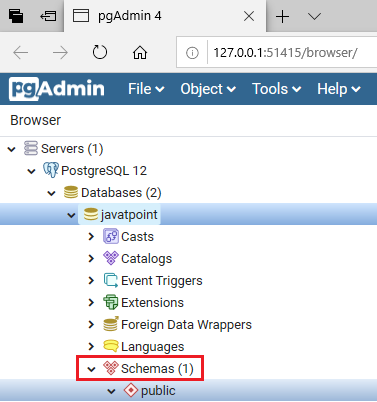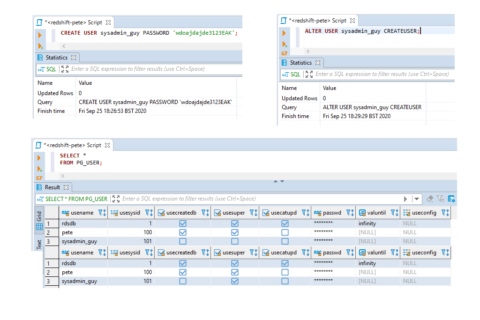

- #POSTGRES CREATE SUPERUSER HOW TO#
- #POSTGRES CREATE SUPERUSER INSTALL#
- #POSTGRES CREATE SUPERUSER UPGRADE#
- #POSTGRES CREATE SUPERUSER PASSWORD#
The name sounds great but i could find nowhere what effectively gets granted. In anycase this 'azure_pg_admin' role is a black box to me. Granting the role 'azure_pg_admin' to user SDE doesn't help further.
#POSTGRES CREATE SUPERUSER UPGRADE#
We haven't tried to upgrade our gdb yet, maybe will may encounter some troubles there because of missing SU I have tried to kill some User Sessions in Pro (using a connection as SDE user), it failed because of missing permissions. (As far as i know it is/was different on Oracle) So i guess that the SDE user doesn't need to be SU anymore to be allowed to create a Geodatabase on Postgresql. Then, as user SDE, we used the ArcGIS Pro Geoprocessing Tool "Enable Enterprise Geodatabase" to initiate the geodb. We created the database manually as well (as user SDE).
#POSTGRES CREATE SUPERUSER INSTALL#
You need to create the group role with the INHERIT attribute.Can testify that we could install a enterprise Geodatabase (SDE/Postgresql) on Azure Flex (Postgresql, no HA) with the non-SU SDE. You can remove a role from a group role using: REVOKE FROM Įxample: REVOKE employee FROM flavio Group role attributesīy default, adding a role to a group role will not make the role inherit attributes (permissions) from the group role.
#POSTGRES CREATE SUPERUSER PASSWORD#
Once the group role is created, you can add roles to the group role using GRANT: GRANT TO įor example, we can create a flavio user role, a “employee” group role, and assign the user to the group role: CREATE USER flavio PASSWORD 'superSecret123$' CREATE ROLE employee GRANT employee TO flavio The syntax is the same as creating a role. To create a group role, type CREATE ROLE Roles will inherit the permissions of roles granted to them, if those roles have the INHERIT attribute. Instead you can create roles with certain permissions, and then grant those roles to other roles. In PostgreSQL, there are no groups of users. REPLICATION / NOREPLICATION: grant (or not) replication permissions (an advanced topic we’ll not cover).
 INHERIT / NOINHERIT: allow (or not) the ability to make the privileges inheritable. CREATEUSER / NOCREATEUSER: allow (or not) the ability to create new users. CREATEROLE / NOCREATEROLE: allow (or not) the ability to create new roles. CREATEDB / NOCREATEDB: allow (or not) the ability to create new databases. A database superuser will bypass other permission checks, except for LOGIN (it must be granted separately).
INHERIT / NOINHERIT: allow (or not) the ability to make the privileges inheritable. CREATEUSER / NOCREATEUSER: allow (or not) the ability to create new users. CREATEROLE / NOCREATEROLE: allow (or not) the ability to create new roles. CREATEDB / NOCREATEDB: allow (or not) the ability to create new databases. A database superuser will bypass other permission checks, except for LOGIN (it must be granted separately).  SUPERUSER / NOSUPERUSER: allow (or not) superuser permissions. LOGIN / NOLOGIN: allow (or not) to login to PostgreSQL. We saw the LOGIN role attribute already, to allow a role to login.īut what are other built-in role attributes we can use? We can add it using: ALTER ROLE WITH LOGIN Built-in role attributes Let’s suppose we created a role without the LOGIN attribute: CREATE ROLE PASSWORD '' You can add a password by using the PASSWORD keyword: CREATE ROLE WITH LOGIN PASSWORD '' CREATE USERĪn alternative way to define roles with the LOGIN attribute automatically added (effectively creating users that can login) is to use CREATE USER: CREATE USER PASSWORD '' Adding a role attribute to a roleĪ role attribute can be added later on to a role using the ALTER ROLE command. Of course it’s very important to have (secure) passwords. In the previous CREATE ROLE command we created a role without password. Notice that the prompt changed from =# to => because we don’t have the Superuser role attribute now. Try by adding the command \q to quit, and then psql postgres -U testing: We can see that the testing role can login, because we don’t have the Cannot login role attribute this time: If we remove that role using: DROP ROLE Īnd add WITH LOGIN this time: DROP ROLE testing CREATE ROLE testing WITH LOGIN To fix this problem we must add the LOGIN role attribute at creation: CREATE ROLE WITH LOGIN You can try by typing the \q command, and then psql postgres -U testing, but you’ll see this error: Our newly created user will not be able to login. This can be accomplished using the CREATE USER command: CREATE USER librarian CREATE ROLE SELECT usename FROM pguser usename - postgres librarian (2 rows) Viewing Existing User Permissions It can often be useful to examine the existing permissions assigned to the users in the system. We got a new role, with the Cannot login role attribute. See? I have the following roles attributes by default:Īnd I’m not a member of any other role (more on this later) Creating a new roleĪ new role is created using the CREATE ROLE command: CREATE ROLE In my case the flaviocopes role was created, and I can see it by using the \du command: There are no users in PostgreSQL, just roles.īy running psql postgres in your terminal, you’ll automatically login with your macOS username to PostgreSQL, therefore accessing the role created. When first installing PostgreSQL on macOS, the script created a role with your macOS username, with a list of permissions granted. In PostgreSQL, all is built around the concept of role.
SUPERUSER / NOSUPERUSER: allow (or not) superuser permissions. LOGIN / NOLOGIN: allow (or not) to login to PostgreSQL. We saw the LOGIN role attribute already, to allow a role to login.īut what are other built-in role attributes we can use? We can add it using: ALTER ROLE WITH LOGIN Built-in role attributes Let’s suppose we created a role without the LOGIN attribute: CREATE ROLE PASSWORD '' You can add a password by using the PASSWORD keyword: CREATE ROLE WITH LOGIN PASSWORD '' CREATE USERĪn alternative way to define roles with the LOGIN attribute automatically added (effectively creating users that can login) is to use CREATE USER: CREATE USER PASSWORD '' Adding a role attribute to a roleĪ role attribute can be added later on to a role using the ALTER ROLE command. Of course it’s very important to have (secure) passwords. In the previous CREATE ROLE command we created a role without password. Notice that the prompt changed from =# to => because we don’t have the Superuser role attribute now. Try by adding the command \q to quit, and then psql postgres -U testing: We can see that the testing role can login, because we don’t have the Cannot login role attribute this time: If we remove that role using: DROP ROLE Īnd add WITH LOGIN this time: DROP ROLE testing CREATE ROLE testing WITH LOGIN To fix this problem we must add the LOGIN role attribute at creation: CREATE ROLE WITH LOGIN You can try by typing the \q command, and then psql postgres -U testing, but you’ll see this error: Our newly created user will not be able to login. This can be accomplished using the CREATE USER command: CREATE USER librarian CREATE ROLE SELECT usename FROM pguser usename - postgres librarian (2 rows) Viewing Existing User Permissions It can often be useful to examine the existing permissions assigned to the users in the system. We got a new role, with the Cannot login role attribute. See? I have the following roles attributes by default:Īnd I’m not a member of any other role (more on this later) Creating a new roleĪ new role is created using the CREATE ROLE command: CREATE ROLE In my case the flaviocopes role was created, and I can see it by using the \du command: There are no users in PostgreSQL, just roles.īy running psql postgres in your terminal, you’ll automatically login with your macOS username to PostgreSQL, therefore accessing the role created. When first installing PostgreSQL on macOS, the script created a role with your macOS username, with a list of permissions granted. In PostgreSQL, all is built around the concept of role. #POSTGRES CREATE SUPERUSER HOW TO#
In this tutorial I will explain how to managing users and permissions in PostgreSQL.







 0 kommentar(er)
0 kommentar(er)
